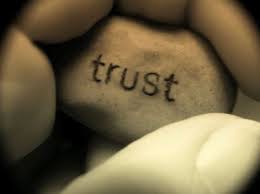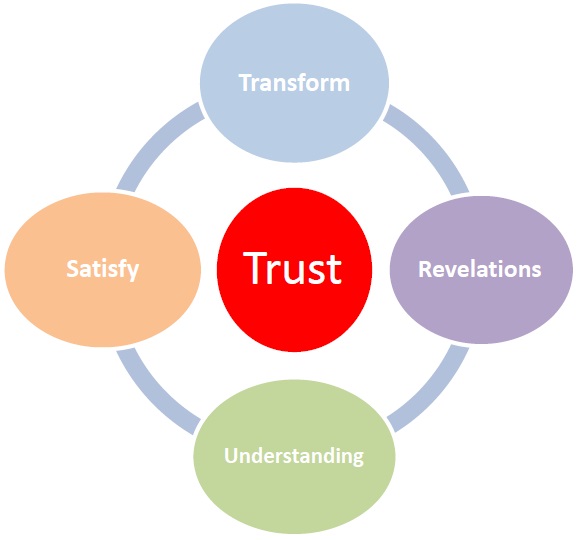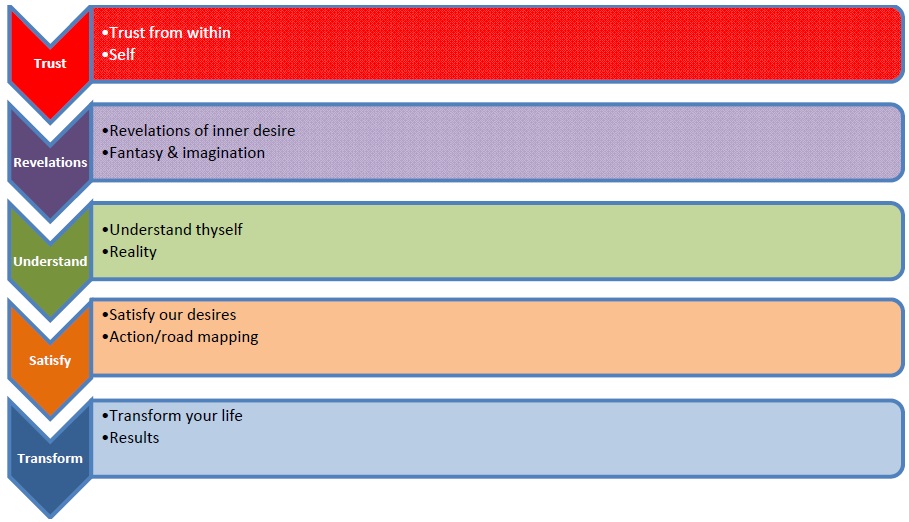A Coaching Model Created by Ginger Beehler
(Business Coach, UNITED STATES)
Your soul knows the geography of your destiny. Your soul alone has the map of your future. John O’Donohue
 Trust Model
Trust Model
 The concept of the coaching model
The concept of the coaching model
The TRUST coaching model is based on the fundamental concept that we all need to search inside ourselves and use trust as a guiding force in our lives in order to achieve the things that are important and reflect our truths on the journey of life.
This model encourages clients to rely on their self‐trust, which influences our feelings, thoughts, decisions and actions. By making trust our center and filter in making choices, it ensures clients live and choose from an authentic place in order to align with their true purpose and desires, which in turn leads to self‐fulfillment and happiness.
If we look at the definition of “trust” it says the following: A firm belief in the reliability, truth, ability, or strength of someone or something. This core definition of trust serves as the fundamental basis of the TRUST coaching model in guiding its clients through the coaching process.
How Coaches play a role in the model
The coaching process believes that all people inherently know what the right answer is for them. An imminent part of this “knowing” is to rely on self trust. It is possible to know something and not necessarily trust in it. This inner conflict can create blocks when people overshadow their trust and knowing with a sense of doubt. Doubt can be the seed for indecision, lack of confidence and even keep people “stuck.” If trust and belief aren’t used as the forefront for client’s actions, creating change can be difficult. The coaching model can help people to move to the space of trust to create positive outcomes on goal settings. This model stresses that the mind and emotions of clients must be adequately prepared before actions begin. Coaches play an important part in helping the clients prepare.
Coaching seeks to benefit the client to assist in the process of client’s identifying their own needs, desires and goals. Coaches can assist clients to identify and clarify their truths, help clients build the trust within them and move the client forward with that trust to make the best decisions for themselves. This mind/emotional state will be used as the cornerstone for fueling action steps, results and transformation for clients. Coaches can help explore, guide and motivate the client on their journey from start to finish (or in some cases on‐going if multiple goals are to be achieved).
Listed below are the steps of the TRUST coaching model and how the stages work to help clients, along with the support of the coach.
TRUST Model Framework
 T ‐Trust from within (self)
T ‐Trust from within (self)
Clients usually come to the coach because they want to change something in their lives that is not currently serving them well. After the client has given a description of their situation and what they would like to change, the initial step is for the coach and client to explore the client’s beliefs about the situation (and general beliefs), as self beliefs serves as an instrumental foundation to the person’s being. How has these beliefs hurt or helped the clients in the past from accomplishing what they wanted? The coach should ask important questions such as, what are your beliefs about yourself, others, the world, etc.? What are the messages we speak to ourselves? Clients should ensure they use an honest approach to assess themselves, analyze the way they trust or don’t trust. It’s important that the client identify what their beliefs are (eliminating outside opinions) and what they need to build, remove or adjust within themselves to established the trust level they need in order to move forward. This step must be explored first to prepare for the following stage of the model. I like to refer this as “mental preparation” for things to come, like a runner who stretches to prevent injury before running. In the trust stage, clients must mentally prepare, so they do not set themselves up for negative outcomes once action steps are implemented. Trusting in one’s abilities is vital to achieve anything we want in life. The coach should ensure that the client takes the time to explore and assess their current trust and self‐confidence level and also assess where they would like to be. What mental and emotional changes need to occur (identify mental/emotional roadblocks as well in this process)? If a certain level of self trust cannot be established it can hinder the client’s ability to move forward and be successful in other stages of this model.
R – Revelations of Inner desire (fantasy/imagination)
This is the second part of the exploration stage, once we’ve established self trust we can then be authentic about what it is we really want from our lives. The stage involves honesty in what serves us and our life purpose. While using our personal truths, what do they reveal to us and our desires? Are we living a life worth living? Are we thriving or surviving? What does your soul and spirit really desire that will help create a happy and full life? Note: Soul can also be explained as what’s in your heart, what fulfills you or makes your heart happy/sing? Spirit can also be interchangeable with what makes you feel enthusiastic, what excites, motivates or gives you passion. When our revelations come and clarity is established on what direction we want to head, the coach should ask the following questions. What makes you happy? If your life was exactly how you imagined it, what would it look like? This can be considered a brainstorming session to get clarity on the goals the client would like to set based on their revelations in order to begin to create the map to self understanding. This is the space of possibilities, not a place for fears that often distort our truths (fantasy and imagination should be encouraged in this stage by coaches). Since the client is now in a trusting place, they can more authentically envision the life they’d like without fear or limitations. You can also explore childhood fantasies, quite often this can be a hint as to what the client’s uninhibited dreams were as a child (many believe your life purpose may be what you dreamed of, were drawn to, or passionate about when you were a child). This stage is about thinking and seeing through the eyes of your own free spirit, the “what if’s.” The key word to keep in mind throughout this stage is “possibilities.”
U ‐ Understanding thyself (reality)
This stage is all about understanding our current reality, where we are in life by assessing our outer life and how that ties into our inner being and how that fits with where we’d like to be. The client needs to understand and assess their personal situation (i.e. emotionally, mentally, financially, relationships, etc.) and assess what are the obstacles that may hinder them in achieving what they want. How far is the client from reality to their fantasy (aka, goals)? Coaches help clients explore how they can overcome any roadblocks (mental, emotional or circumstantial). This is a stage to really look at our fears and what’s holding us back from getting what we want. What is working in our lives and what isn’t? The client takes ownership of things that have happened in their lives (good or bad) and what lessons they’ve learned. If fear, doubts, lack of self confidence, etc. has held them back in the past, the coach and client discusses these issues. What can the client do to change those fears, while also keeping in mind; courage is not the absence of fear, but the ability to move forward in spite of them. Clients should list down their strengths and weakness, what motivates and what de‐motivates them. What are the potential obstacles or possible triggers to hinder progress and plan to maneuver around or overcome this? What is the client’s confidence level to move forward, how much conviction does the client hold that they can achieve what they want? What is the motivation level to start thinking about how to achieve your goals? Make adjustments where needed in order to mentally and emotionally prepare to move into the action stage. The clients now integrate their personal trust, revelations and understanding oneself (the emotional prep stage steps) to move into the next stage, the steps of actions.
S ‐ Satisfy our desires (action/road mapping)
This is the action stage where you move to satisfy yourself, the client defines the goals, has an action plan and timeline of reaching the goals. The client now comes armed with the emotional and mental understanding. They have included in their action plan, potential pitfalls and plans to overcome them. The coach works with the client every step to ensure a solid and achievable action plan can be set in motion. As part of the action plan, coaches should ask thought provoking questions such as, how will achieving this goal make your life better and how will it affect you if you don’t achieve the goal? What will the outcome look like, how will you feel and think after this has been completed? The action plan serves as a road map of what steps need to be taken, along with commitments to timelines of when these action steps will be completed. This is a concrete way to monitor progress, make adjustments if you encounter unforeseen obstacles and above all reflects your commitment level to your action plan. The action plan should be clearly defined and written out. As each step is completed, clients should journal how they feel along the way. They should write their experiences, what they found helpful and not helpful (include any successes along the way). Coaches are to hold the client accountable to complete the action steps in the timeframes that were agreed upon. If the actions steps are not completed, coaches discuss the reasons with clients and how to overcome it.
T ‐ Transform your life (results)
This is the final step and is considered the results and reflective stage. This stage should be used with clients to discuss has the goal been achieved and are they happy with the result(s)? Assuming clients are happy with the outcome, it’s time for the client and coach to acknowledge where the client started from and where they are now. By taking steps to achieve one’s goal the client transforms by evolving through the process, learning about themselves, their potential and abilities, and hopefully become more authentic to themselves. Dreams are now reality and are achieved, which means the client is empowered to move forward with what has been accomplished. It’s important to assess in this stage, what kind of maintenance does it take to retain this goal? What has the client learned about themselves and this journey? How has the client transformed as a person (good or bad), what has changed with the clients inner being, as well as outer being (include aspects of self – emotional/mental state, confidence, self esteem, happiness level, as well as relationships, job, friends, family, etc.). How has this impacted clients core beliefs (compare the end beliefs to the beginning beliefs), what has the client learned about themselves, how has this transformation been reflected in their life, what has changed for the better through their actions, and what would they have done differently? Other questions for clients to ponder, what will you carry with you going forward from this experience, how does success feel, what’s changed about you through the process (thinking, feeling, attitude, belief in oneself, confidence). It’s important at this stage that if clients have journaled their progress that they re‐read and assess what they wrote (this is their own personal story of their journey). If the client is now ready to set a new goal or built on the current goal, revisit any of the steps in this model to assist in helping the clients achieve what they want. Coaches should check in with the client to ask for feedback on what the client found helpful in the coaching process and address any areas of improvement in this last stage.
The TRUST coaching model integrates the process of using the coach’s listening skills and understanding to help clients develop their own understanding, a plan and strategy that incorporates the client’s wants and needs. The coach acts as a listener, supporter, which is balanced with honest and direct communications and holding the client accountable to take responsibility for their own life and achievements.
Your destiny can only be unlocked and discovered from within and it is a journey that only you can make-Eleesha